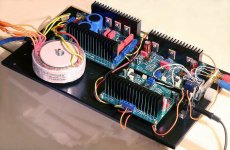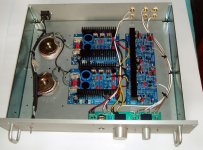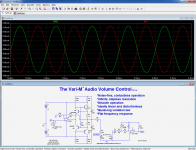do a highly relevant PowerCube-type measurement on power amps.
For an individual buyer, 90% of the cube data would also be irrelevant.
More rational (and interesting) to do a PC-measurement for both.
What is "Cube data"?
PowerCube. It's a means of measuring amplifier drive capability into loads of varying complex impedance.
the most important question for a consumer
Will this preamp drive my power amplifier, plus 2 x 10ft of spaced-out interconnect cable.

Usual definition: sum of the currents through the two OP transistors constant, and no one ever turning off.
Never saw that definition, how would that work on a SET amp. The current in the one output device is not constant.
The benefit of that circuit is the fact that it is an additional closed-loop buffer around the Vbe's of the output devices. As Jan points out you still see the harmonic energy at the supplies. A geometric mean circuit with equally huge standing current would also not get anywhere near switching off at 2X output but would have a lot more dynamic headroom.
EDIT - At 1 amp bias for both, one circuit has 2A and 0A for 2A out, the other has 2.41A and .41A and room for more output.
Last edited:
...spaced-out interconnect cable.
Give it some black coffee and walk it around a bit.
This 600 ohms is not fashion. It is a norm in audio pro and telecommunication.
For those who don't remember, the standard is 600 ohm symmetrical.
The reference level, 0dBu, is +4dB (1.23V rms).
The standard connecting is XLR.
Best professional studio gears offers +19/+21dB of headroom.
With ordinary diodes instead of the schottky, and 15 ohms as emitter resistances, my simple schematic can offers 40mA of quiescent (class A on all the range), and the following distortions in simulation (depending of the OPA used), on a 600 Ohm load with an overall gain of 10 :
+4dB 1000Hz = 0.000002%
+4dB 10 000Hz = 0.000006%
+17dB 1000Hz = 0.000200%
+17dB, 10000Hz = 0.000400% (four harmonics)
-3db bandwidtch is 9MHz with this OPA.
Headroom is 19dB. Good enough to drive any 600/600 line transformer ?
But class A means the output devices have to dissipate something like 1 Watt at quiescent. And some current protection, rail side, to prevent damage in case of short circuit, specially if used in PA systems.
For those who don't remember, the standard is 600 ohm symmetrical.
The reference level, 0dBu, is +4dB (1.23V rms).
The standard connecting is XLR.
Best professional studio gears offers +19/+21dB of headroom.
With ordinary diodes instead of the schottky, and 15 ohms as emitter resistances, my simple schematic can offers 40mA of quiescent (class A on all the range), and the following distortions in simulation (depending of the OPA used), on a 600 Ohm load with an overall gain of 10 :
+4dB 1000Hz = 0.000002%
+4dB 10 000Hz = 0.000006%
+17dB 1000Hz = 0.000200%
+17dB, 10000Hz = 0.000400% (four harmonics)
-3db bandwidtch is 9MHz with this OPA.
Headroom is 19dB. Good enough to drive any 600/600 line transformer ?
But class A means the output devices have to dissipate something like 1 Watt at quiescent. And some current protection, rail side, to prevent damage in case of short circuit, specially if used in PA systems.
Attachments
Last edited:
This 600 ohms is not fashion. It is a norm in audio pro and telecommunication.
For those who don't remember, the standard is 600 ohm symmetrical.
The reference level, 0dBu, is +4dB (1.23V rms).
Best studio gears offers +19/+21dB of headroom.
With ordinary diodes instead of the schottky, and 15 ohms as emitter resistances, my simple schematic can offers 40mA of quiescent (class A on all the range), and the following distortions in simulation (depending of the OPA used), on a 600 Ohm load with an overall gain of 10 :
+4dB 1000Hz = 0.000002%
+4dB 10 000Hz = 0.000006%
+17dB 1000Hz = 0.000200%
+17dB, 10000Hz = 0.000400% (four harmonics)
Headroom is 19dB. Good enough to drive any 600/600 line transformer ?
But class A means the output devices have to dissipate something like 1 Watt at quiescent. And some current protection, rail side, to prevent damage in case of short circuit, specially if used in PA systems.
You did bother to move D1 in the right place, isn't it?
And about those distortions, 0.06ppm=60ppb=-144dB at 10KHz, sounds like a little bit of a simulation stretch, isn't it? Why? Because the LT1363 LTSpice model is a simple MPZ (multiple pole zero) model that is good for a linear analysis (like AC sweep in Spice) but completely improper for any nonlinear analysis like TRAN and distortion analysis. You may want to check the LTC.lib file for the LT1363 model. There are very few device level opamp models available to the public, one is notably the LME49710, but even with such a model I would take the simulation distortion results with a pinch of salt.
At least you gave up the idea of replacing the LT1363 high current output with a 1mA biased output stage.
Last edited:
Got it, thank you, Dimitri.
But class A means the output devices have to dissipate something like 1 Watt at quiescent.
In which case, Damir's looks prettier.
And maybe Elvee feels evil enough to do an Allison in self-biasing wonderland, with a stacked output stage.
(back in the day, some did ZC-Top preamp measurements in these parts, not sure about the coffee)
Last edited:
This 600 ohms is not fashion. It is a norm in audio pro and telecommunication.
Yes, sometimes. And for those applications, one designs for it. Home audio? Nope.
Agree, its overkill.Home audio? Nope.
(Oh, it looks like my domestic fly is definitively glued on the sticky paper, bzzz bzzz.)
...
But class A means the output devices have to dissipate something like 1 Watt at quiescent. And some current protection, rail side, to prevent damage in case of short circuit, specially if used in PA systems.
So? You should start worrying when the output devices have to start dissipating something like 3W, even on demand only.
True, you will have the added hassle of heat sinking them locally, which does add cost, needs more space and prohibits really small size, but for a standard 19" 2HE case, that's not a problem at all.
And, judging from my own experience, deep class A (where the bias current dissipation exceeds the maximum required by the design by a factor of say 1.5 at least, preferably 2) does have its sonic rewards, believe me. It's a quality which trascends pure measurement, but it's obvious enough at first listening.
On picture 1, a close up of the prototype I developed the headphones on. Left two heatsinks are for the shunt PSU, right two cool off the output stage.
Pisture 2 shows the dual mono final form version. As you can see, still quite a bit of space left.
Pisture 2 shows the dual mono final form version. As you can see, still quite a bit of space left.
Attachments
No, it only works for symetrical circuits. In a symetrical circuit, if the sum of the currents is not constant, this means that the class A is "tainted" with a class B component. OK, it may be class A since Jan says so, but I don't call that "pure" class A.Never saw that definition, how would that work on a SET amp. The current in the one output device is not constant.
I didn't call my various x-clophone topologies class A for that reason (but after all, the jury decided they were)
Yes, that is one of the reasons for the exceptional linearity (but not the only one)The benefit of that circuit is the fact that it is an additional closed-loop buffer around the Vbe's of the output devices.
No: see screenshot below, the currents contain only DC and the fundamental.As Jan points out you still see the harmonic energy at the supplies.
Maybe, but keeping the simple sum constant has the advantage of keeping the dynamic output resistance for the OP stage as whole constant, which is clearly an advantage regarding current-induced non-linearitiesA geometric mean circuit with equally huge standing current would also not get anywhere near switching off at 2X output but would have a lot more dynamic headroom.
Attachments
Oh, what's this ? Moving two coupled coils distance, or relative angle, to change the gain ? That's the idea ?see screenshot below, the currents contain only DC and the fundamental.
(I love your way, Elvee, to walk on the wild side)
Last edited:
No: see screenshot below, the currents contain only DC and the fundamental.
Yes, I should have noticed the arithmetic mean does that too (I could blame it on Jan
With a difficult speaker load like one that goes down to very low impedance over part of its range would require a rather large quiescent current to cover high crest factor music.
Last edited:
- Status
- Not open for further replies.
- Home
- Member Areas
- The Lounge
- John Curl's Blowtorch preamplifier part II


